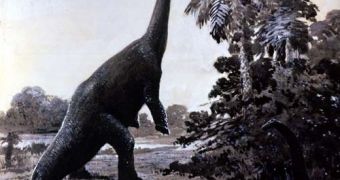The sauropods were the largest animals to have ever inhabited the planet. No beasts before or since managed to equal them in size and might. They fed on herbs and leaves, and researchers believe that they evolved their massive bodies in order to be able to reach the tallest canopies. This also enabled these dinosaurs to eat from areas that were out of reach for most other species, therefore they had no competition. But a new research seems to suggest that these impressive animals were a little less adapted to actually chewing the tons of vegetation they ate each day. According to paleontologists, the small size of their heads might have been the main reason why this behavior occurred, LiveScience reports.
The new conclusions are based on a thorough analysis conducted by researchers on four dinosaur skulls, belonging to animals that lived approximately 105 million years ago, well before the Cretaceous-Tertiary (K-T) extinction event. This boundary saw the extinction of all non-avian dinosaurs. “They didn't chew their food; they just grabbed it and swallowed it,” Brigham Young University paleontologist and study team member Brooks Britt explains. It would appear that these animals did not have mothers nagging them about the benefits of chewing their food before eating it.
The closest relative of the analyzed dinosaurs, called Abydosaurus mcintoshi, is the famous Brachiosaurus, a sauropod that lived some 45 million years earlier. The fossilized skulls, of which two featured complete and intact bones, were recovered from eastern Utah, in a region now called the Dinosaur National Monument. A. mcintoshi was a sauropod as well, featuring a bulky body, a long neck and a small head. The reason why these four skulls are so important is because they finally give solid scientific foundation to a theory that academics have circulated for a long time, namely that sauropods were not in the habit of chewing what they ate.
“If you have a tiny skull and you're trying to feed a big body, you're wasting time if you're trying to process the food in your mouth,” University of Michigan Department of Geological Sciences and Museum of Paleontology expert Jeffrey Wilson explains. Most sauropods had a head size of about 1/200th of their body, which means that they needed to keep the food rolling in order to survive. The largest animals to walk the land reached as much as 120-139 metric tons in weight, so they needed to eat almost around the clock. They moved in flocks and razed an area to bare ground before moving to the next region.
“For some reason sauropods don't develop any of the tricks that other dinosaurs developed for eating plants. Our explanation [is that] these adaptations are not good evolutionary investments for an animal whose skull is so small compared to [the] rest of its body. The sauropod strategy is to bite the food, maybe bite it once more, and then swallow it and let it digest in your gut,” Wilson adds. Details of the investigation appear in the latest issue of the respected scientific journal Naturwissenshaften.

 14 DAY TRIAL //
14 DAY TRIAL //